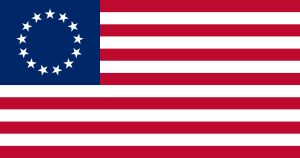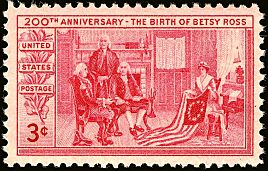Betsy Ross facts for kids
Quick facts for kids
Betsy Ross
|
|
|---|---|
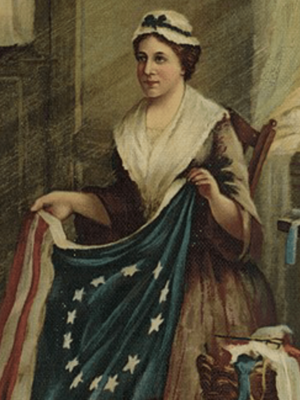
Posthumous depiction of Ross in 1893
|
|
| Born |
Elizabeth Griscom
January 1, 1752 |
| Died | January 30, 1836 (aged 84) Philadelphia, Pennsylvania, U.S.
|
| Occupation | Upholsterer |
| Years active | 1768–1833 |
| Spouse(s) |
John Ross
(m. 1773; Joseph Ashburn
(m. 1777; John Claypoole
(m. 1783; |
| Children | 7 |
| Parents |
|
| Family |
|
| Signature | |
Elizabeth Griscom Ross (née Griscom; January 1, 1752 – January 30, 1836), also known by her second and third married names, Ashburn and Claypoole, was an American upholsterer who was credited by her relatives in 1870 with making the first official U.S. flag, accordingly known as the Betsy Ross flag. Though most historians dismiss the story, Ross family tradition holds that General George Washington, commander-in-chief of the Continental Army and two members of a congressional committee—Robert Morris and George Ross—visited Mrs. Ross in 1776. Mrs. Ross convinced George Washington to change the shape of the stars in a sketch of a flag he showed her from six-pointed to five-pointed by demonstrating that it was easier and speedier to cut the latter. However, there is no archival evidence or other recorded verbal tradition to substantiate this story of the first U.S. flag. It appears that the story first surfaced in the writings of her grandson in the 1870s (a century after the fact), with no mention or documentation in earlier decades.
Ross made flags for the Pennsylvanian navy during the American Revolution. After the Revolution, she made U.S. flags for over 50 years, including 50 garrison flags for the U.S. Arsenal on the Schuylkill River during 1811. The flags of the Pennsylvania navy were overseen by the Pennsylvania Navy Board. The board reported to the Pennsylvania Provincial Assembly's Committee of Safety. In July 1775, the President of the Committee of Safety was Benjamin Franklin. Its members included Robert Morris and George Ross. At that time, the committee ordered the construction of gunboats that would eventually need flags as part of their equipment. As late as October 1776, Captain William Richards was still writing to the committee or Council of Safety to request the design that he could use to order flags for their fleet.
Ross was one of those hired to make flags for the Pennsylvanian fleet. An entry dated May 29, 1777, in the records of the Pennsylvania Navy Board includes an order to pay her for her work. It is worded as follows:
An order on William Webb to Elizabeth
Ross for fourteen pounds twelve shillings and two
pence for Making Ships Colours [etc.] put into William
Richards store……………………………………….£14.12.2
The Pennsylvania navy's ship color included (1) an ensign; (2) a long, narrow pennant; and (3) a short, narrow pennant. The ensign was a blue flag with 13 stripes—seven red stripes and six white stripes in the flag's canton (upper-left-hand corner). It was flown from a pole at the rear of the ship. The long pennant had 13 vertical, red-and-white stripes near the mast; the rest was solid red. It flew from the top of the ship's mainmast, the center pole holding the sails. The short pennant was solid red, and flew from the top of the ship's mizzenmast—the pole holding the ship's sails nearest the stern (rear of the ship).
Contents
Early life and education
Betsy Ross was born on January 1, 1752, to Samuel Griscom (1717–1793) and Rebecca James Griscom (1721–1793) on the Griscom family farm in Gloucester City, New Jersey. Ross was the eighth of seventeen children, of whom only nine survived childhood. A sister, Sarah (1745–1747), and brother, William (1748–1749), died before Elizabeth ("Betsy") was born (another sister, Sarah Griscom Donaldson (1749–1785), was named after the earlier deceased Sarah). Ross was just five years old when her sister Martha (1754–1757) died, and another sister, Ann (1757–1759), only lived to the age of two. Brothers Samuel I (1753–1756) and Samuel II (1758–1761) both died at age three. Two others, twins, brother Joseph (1759–1762) and sister Abigail (1759–1762), died in one of the frequent smallpox epidemics in the autumn of 1762. Ross grew up in a household where the plain dress and strict discipline of the Quakers dominated. She learned to sew from a great aunt, Sarah Elizabeth Ann Griscom. Ross's great-grandfather, Andrew Griscom, a member of the Quakers and a carpenter, had emigrated in 1680 from England.
After her schooling at a Quaker-run state school, Ross's father apprenticed her to an upholsterer named William Webster.
"First flag"
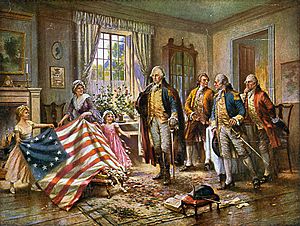
It was widely believed that Betsy Ross designed the "first U.S. flag". The design with its easily identifiable circle of stars, has long been regarded as a symbol of the American Revolution and the young Republic. It is featured prominently in a number of post-Revolutionary paintings about the war, such as General George Washington at Trenton (1792).
A popular story has it that Ross was hired by a group of founding fathers to make the flag. According to the legend, she deviated from the 6-pointed stars in the design and produced a flag with 5-pointed stars, instead.
However, there is no consensus on what the first U.S. flag looked like, nor who produced it.
There were at least 17 flag makers and upholsterers who worked in Philadelphia during the time these early American flags were made. Margaret Manny is thought to have made the first Continental Colors (or Grand Union Flag), but there is no evidence to prove she also made the Stars and Stripes. Other flag makers of that period include Rebecca Young, Anne King, Cornelia Bridges, and flag painter William Barrett. Any flag maker in Philadelphia could have sewn the first American flag. So, there may not be one "first" flag, but many.
In 1870, Ross's grandson, William J. Canby, presented a research paper to the Historical Society of Pennsylvania in which he claimed that his grandmother had "made with her hands the first flag" of the United States. Canby said he first obtained this information from his aunt Clarissa Sydney (Claypoole) Wilson in 1857, 20 years after Ross's death. Canby dates the historic episode based on Washington's journey to Philadelphia, in the late spring of 1776, a year before the Second Continental Congress passed the first Flag Act of June 14, 1777.
Modern scholars, however, tend to think that Ross's only contribution to the flag design was to change the 6-pointed stars to the easier 5-pointed stars while Francis Hopkinson, a member of the Continental Congress, is given credit for the stars arrangement.
Personal life
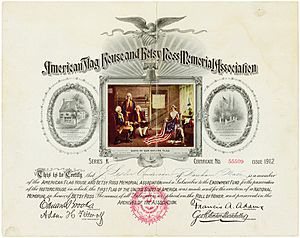
Griscom met John Ross (nephew of George Ross Jr, signer of the United States Declaration of Independence), who was the son of the Rev. Aeneas Ross (and his wife Sarah Leach), a Church of England (later Episcopal) priest and assistant rector at the historic city parish of Christ Church while being apprenticed to upholsterer William Webster. The couple eloped in 1773, marrying at Hugg's Tavern in Gloucester City, New Jersey.
The marriage caused a split from her Griscom family and meant her expulsion from the Quaker congregation. The young couple soon started their own upholstery business and later joined Christ Church, where their fellow congregants occasionally included visiting colony of Virginia militia regimental commander, colonel, and soon-to-be-general George Washington (of the newly organized Continental Army) and his family from their home Anglican parish of Christ Church in Alexandria, Virginia, near his Mount Vernon estate on the Potomac River, along with many other visiting notaries and delegates in future years to the soon-to-be-convened Continental Congress and the political/military leadership of the colonial rebellion. Betsy and John Ross had no children.
The American Revolutionary War broke out when the Rosses had been married for two years. As a member of the local Pennsylvania Provincial Militia and its units from the city of Philadelphia, John Ross was assigned to guard munitions. He died in 1775. According to one legend, he was killed by a gunpowder explosion, but family sources provide doubts about this claim. The 24-year-old Elizabeth ("Betsy") continued working in the upholstery business repairing uniforms and making tents, blankets, and stuffed paper tube cartridges with musket balls for prepared packaged ammunition in 1779 for the Continental Army.
There is speculation that Ross was the "beautiful young widow" who distracted Carl von Donop in Mount Holly, New Jersey, after the Battle of Iron Works Hill, thus keeping his forces out of the crucial "turning-of-the-tide" Battle of Trenton on the morning of December 26, 1776, in which Hessian soldiers were defeated after the crossing of the Delaware River.
On June 15, 1777, she married her second husband, mariner Joseph Ashburn. In 1780, Ashburn's ship was captured by a Royal Navy frigate and he was charged with treason (for being of British ancestry—naturalization to American colonial citizenship was not recognized) and imprisoned at Old Mill Prison in Plymouth, England. During this time, their first daughter, Zilla, died at the age of nine months and their second daughter, Eliza, was born. Ashburn died in the British jail.
Three years later, in May 1783, she married John Claypoole, who had earlier met Joseph Ashburn in the English Old Mill Prison; Claypoole had informed Ross of her husband's circumstances and death. John Claypoole's diary and family Bible was rediscovered 240 years later in June 2020.
The couple had additionally five daughters: Clarissa, Susanna, Jane, Rachel, and Harriet (who died in infancy). With the birth of their second daughter Susanna in 1786, they moved to a larger house on Philadelphia's Second Street, settling down to a peaceful post-war existence, as Philadelphia prospered as the temporary national capital (1790–1800) of the newly independent United States of America, with the first president, George Washington, his vice president, John Adams, and the convening members of the new federal government and the U.S. Congress.
In 1793, her mother, father, and sister Deborah Griscom Bolton (1743–1793) all died in another severe yellow fever epidemic (a disease unknowingly caused by infected mosquitoes). After two decades of poor health, John Claypoole died in 1817. Ross continued the upholstery business for 10 more years. Upon retirement, she moved in with her second Claypoole daughter, Susanna (1786–1875), in a section of Abington Township, Montgomery County, Pennsylvania. Her eldest Claypoole daughter, Clarissa (1785–1864), had taken over Ross's business back in the city.
Death and burials
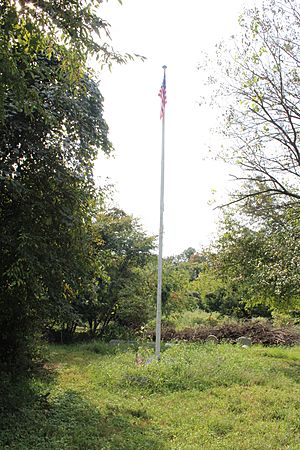
Ross, by then completely blind, spent her last three years living with her middle Claypoole daughter, Jane (1792–1873), in rapidly growing and industrializing Philadelphia. On Saturday, January 30, 1836, 60 years after the Declaration of Independence, Betsy Ross died at the age of 84. She was survived by one daughter with John Ashburn, Eliza, and four daughters with John Claypoole: Clarissa, Susanna, Jane, and Rachel, and one sister, Hannah Griscom Levering (1755–1836), who herself died about 11 months later.
The so-called Betsy Ross House is a popular tourist site in Philadelphia, but it is still a matter of historical academic dispute whether she actually lived there, as evidence indicates she actually lived from 1776 to 1779 in a house next door that was torn down after the remaining house was designated.
Ross's body was first interred at the Free Quaker burial grounds on North Fifth Street in Philadelphia. In 1856, the remains of Ross and her third husband John Claypoole were moved from the Free Quaker Burying Ground to Mount Moriah Cemetery. The practice of cemeteries purchasing the remains of famous historical individuals was common in order to drive additional business. The Daughters of the American Revolution erected a flagpole at the site of her grave in her memory.
In 1975, in preparation for the American Bicentennial, city leaders ordered the remains moved to the courtyard of the Betsy Ross House. However, cemetery workers found no remains beneath her tombstone. Bones found elsewhere in the family plot were deemed to be hers and were reinterred in the current grave visited by tourists at the Betsy Ross House.
Legacy
The Betsy Ross Bridge, connecting Philadelphia with Pennsauken Township, New Jersey, across the Delaware River is named in her honor.
Biographer Marla Miller argues that Ross's legacy should not be about a single flag, but rather because of what her story tells us about working women and men during the American Revolution.
Betsy Ross School in Mahwah, New Jersey is named for her.
Betsy Ross postage stamp
On January 1, 1952, the U.S. Post Office issued a commemorative postage stamp to honor the 200th anniversary of her birth. It shows her presenting the new 13-striped, 13-starred flag to George Washington, with Robert Morris, and George Ross present. The design was taken from a painting by Charles H. Weisberger, one of the founders and first custodian of the Memorial Association, who has cared for and operated the Ross House. This was issued when the Ross legend was still strong and accepted by many of the American public and before additional historical and academic scrutiny.
Ancestry
| Ancestors of Betsy Ross | ||||||||||||||||||||||||||||||||||||||||||||||||||||||||||||||||||||||||||||||||||||||||||||||||||||||||||||||||||||||||||||||||||||||||||||||||||||||||||||||||||||||||||||||||||||||||||||||||||||||||||||||||||||||||||||||||||||||
|---|---|---|---|---|---|---|---|---|---|---|---|---|---|---|---|---|---|---|---|---|---|---|---|---|---|---|---|---|---|---|---|---|---|---|---|---|---|---|---|---|---|---|---|---|---|---|---|---|---|---|---|---|---|---|---|---|---|---|---|---|---|---|---|---|---|---|---|---|---|---|---|---|---|---|---|---|---|---|---|---|---|---|---|---|---|---|---|---|---|---|---|---|---|---|---|---|---|---|---|---|---|---|---|---|---|---|---|---|---|---|---|---|---|---|---|---|---|---|---|---|---|---|---|---|---|---|---|---|---|---|---|---|---|---|---|---|---|---|---|---|---|---|---|---|---|---|---|---|---|---|---|---|---|---|---|---|---|---|---|---|---|---|---|---|---|---|---|---|---|---|---|---|---|---|---|---|---|---|---|---|---|---|---|---|---|---|---|---|---|---|---|---|---|---|---|---|---|---|---|---|---|---|---|---|---|---|---|---|---|---|---|---|---|---|---|---|---|---|---|---|---|---|---|---|---|---|---|---|---|---|
|
||||||||||||||||||||||||||||||||||||||||||||||||||||||||||||||||||||||||||||||||||||||||||||||||||||||||||||||||||||||||||||||||||||||||||||||||||||||||||||||||||||||||||||||||||||||||||||||||||||||||||||||||||||||||||||||||||||||
See also
 In Spanish: Betsy Ross para niños
In Spanish: Betsy Ross para niños


